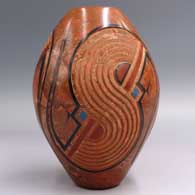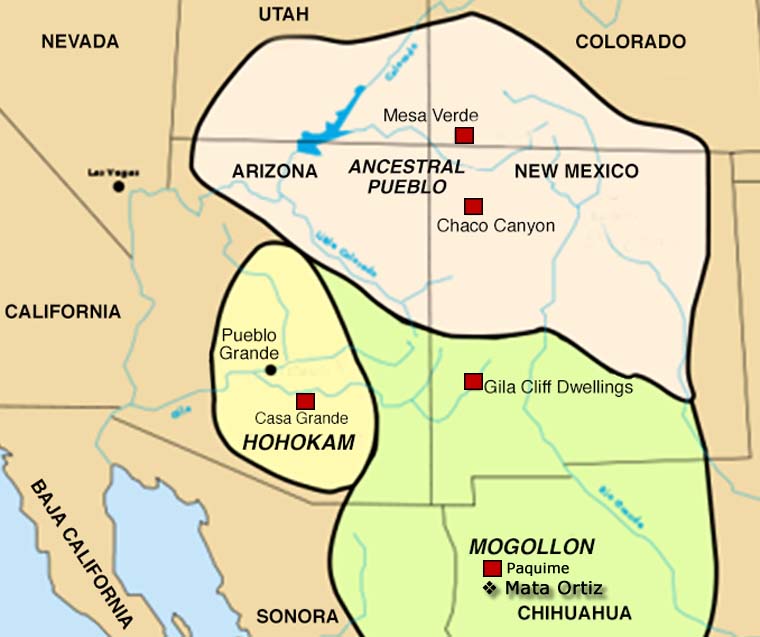
Salvador Baca
Mata Ortiz andCasas Grandes

Salvador and Virginia Baca produce exceptionally thin-walled, finely decorated black ceramics. Virginia learned the basics of pottery making from her sister, Gloria Lozoya de Veloz.
In those days Salvador was working as a corporate accountant. It wasn't long before he realized he preferred making pottery with his wife to counting beans for a faceless corporate entity. Salvador also learned the basics from Virginia's sister, then they moved to Nuevo Casas Grandes to enroll their children in one of the better Mormon schools. That move also allowed both of them to study with Jorge Quintana.
Since 1995, they have worked as a team, each focused on their strengths and pushing themselves forward to the next level of creativity.
Virginia usually forms the very thin wall pieces and sets them aside to dry for several days. Then Salvador takes them one at a time and sands the surfaces. Then he incises design shapes into the surfaces. When done, he then burnishes the surfaces to get a polished and shiny finish. Then, following his incisions, he paints Paquimé designs over much of the surface of each pot.
When Salvador and Virginia go to fire their pots, they begin by placing pieces on the ground and covering them with a metal bucket. Then they build a stack of wood around the bucket and light the wood on fire. At a certain point they smother the fire with cow manure and the oxygen-reduction process created by that turns any exposed clay black.
Their design elements have included polychromes and tan clays in the past but these days, they tend to prefer producing matte black patterns painted on highly polished clay surfaces. Sometimes they add cutouts in the vessel walls. Sometimes they carve stepped surfaces into the sides of a pot.
Some of their pots are tall with flared rims and almost pointed bases. Other of their shapes vary from seed pots with animal-shaped mouths to miniatures that are similar in form to their tall vessels. They also often produce a very popular black-on-black wedding vase, highly polished with high handles and exquisite matte black designs.
The miniatures the Bacas create are well known in the pottery world as they have earned First Place ribbons in the Miniature Division at the Premio Nacional de la Cerámica (National Ceramics Contest) in Tlaquepaque, Mexico several times.
In 2018 Salvador won a First Place prize for a traditional color pot, with or without design, at the annual Concurso Ceramica de Mata Ortiz.
Among Salvador's cousins are Taurina Baca and Luz Elva Ramirez.
100 West San Francisco Street, Santa Fe, New Mexico 87501
(505) 986-1234 - www.andreafisherpottery.com - All Rights Reserved

Mata Ortiz and Casas Grandes

The macaw pens at Paquimé
Casas Grandes is both a municipality and an archaeological district in northern Chihuahua State, Mexico. The archaeological district includes the pre-historic ruins of Paquimé, a city that began to build around 1130 AD and was abandoned about 1450 AD. Archaeologists are uncertain as to whether Paquimé was settled by migrants from the Mogollon/Mimbres settlements to the north or by Anasazi elite from the Four Corners region in the United States or by others. Over the years Paquimé was built into a massive complex with structures up to six and seven stories high with multiple Great Houses in the surrounding countryside. Today, the site is a UNESCO World Heritage Site.
Mata Ortiz is a small settlement inside the bounds of the Casas Grandes municipality very near the site of Paquimé. The fortunes of the town have gone up and down over the years with a real economic slump happening after the local railroad repair yard was relocated to Nuevo Casas Grandes in the early 1960's. The town was in steady decline until Juan Quezada, a poor farmer who gathered firewood in the area of the archaeological site, was inspired by fragments of ancient Paquimé pottery and even older fragments of Mimbres forms with bold black-on-white designs littering the ground to learn more.

Ramos Polychrome effigy pot from Paquimé
Quezada was successful in his quest to learn to recreate the ancient process using slightly more modern techniques (although no one in the present tradition uses a potter's wheel). He learned to use sand and other coarse materials for temper. He discovered that dried cow dung made an excellent and inexpensive firing fuel. Instead of using gourds for smoothing he substituted broken hacksaw blades. Instead of using yucca fiber brushes for painting he learned to make brushes with human hair. He persevered in his efforts and by 1971 had produced a kind of polychrome pottery. Since then, most pottery-making in the area has used innovations in the design and decoration of the pots but the materials and the basic crafting of the process have remained the same.
By the mid-1970s, Quezada had attracted a significant number of traders and his work was becoming a commercial success. That is when he began teaching his techniques to his immediate family. They in turn taught other family members, friends and the younger generations. Both women and men were included from the beginning.
Originally called Casas Grandes pottery in the early years of its production, the potters of this tiny village have made such an impact on the pottery communities, including many awards and special recognition from the Presidents of Mexico, that Mata Ortiz pottery is now becoming known around the world.
Today, pottery production has changed the village in many ways as there is now electricity, plumbing, vehicles and more for the residents. Virtually everyone in the small town (2010 population: 1,182) makes their living by working in some part of the pottery-making process, from potters to clay-gatherers to firewood collectors to traders.
Mata Ortiz pottery incorporates elements of contemporary and prehistoric design and decoration, and each potter or pottery family produces their own distinctive, individualized ware. Young potters from surrounding areas have been attracted to the Mata Ortiz revival and new potting families have developed while the art movement continues to expand. Without the restraints of traditional religious practices or gender constraints, a vibrant flow of new ideas has enabled the pottery of Mata Ortiz to avoid the derivative repetition common to virtually all folk art movements. This blend of economic need, gender equality, cultural expression and artistic freedom has produced a unique artistic movement in today's community.
Lower photo is courtesy of David Monniaux, Creative Commons Attribution-Share Alike 3.0 Unported License
100 West San Francisco Street, Santa Fe, New Mexico 87501
(505) 986-1234 - www.andreafisherpottery.com - All Rights Reserved
